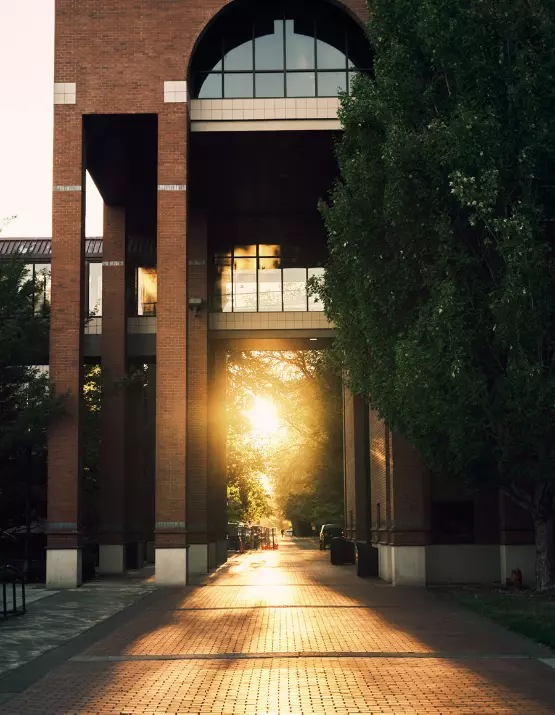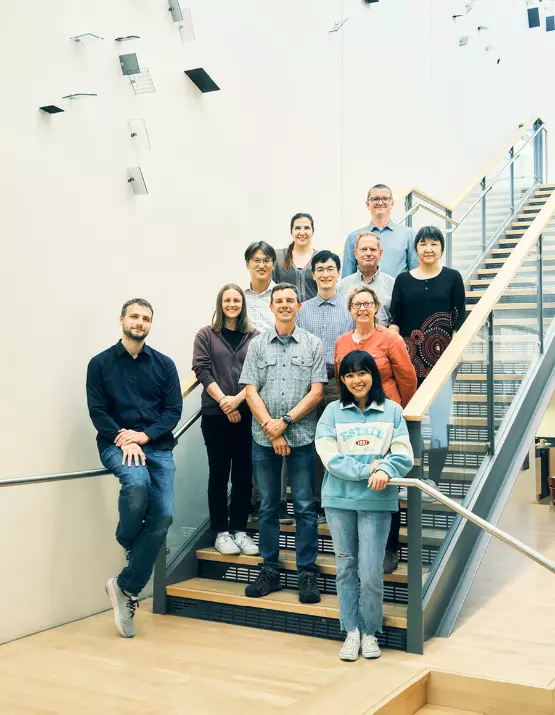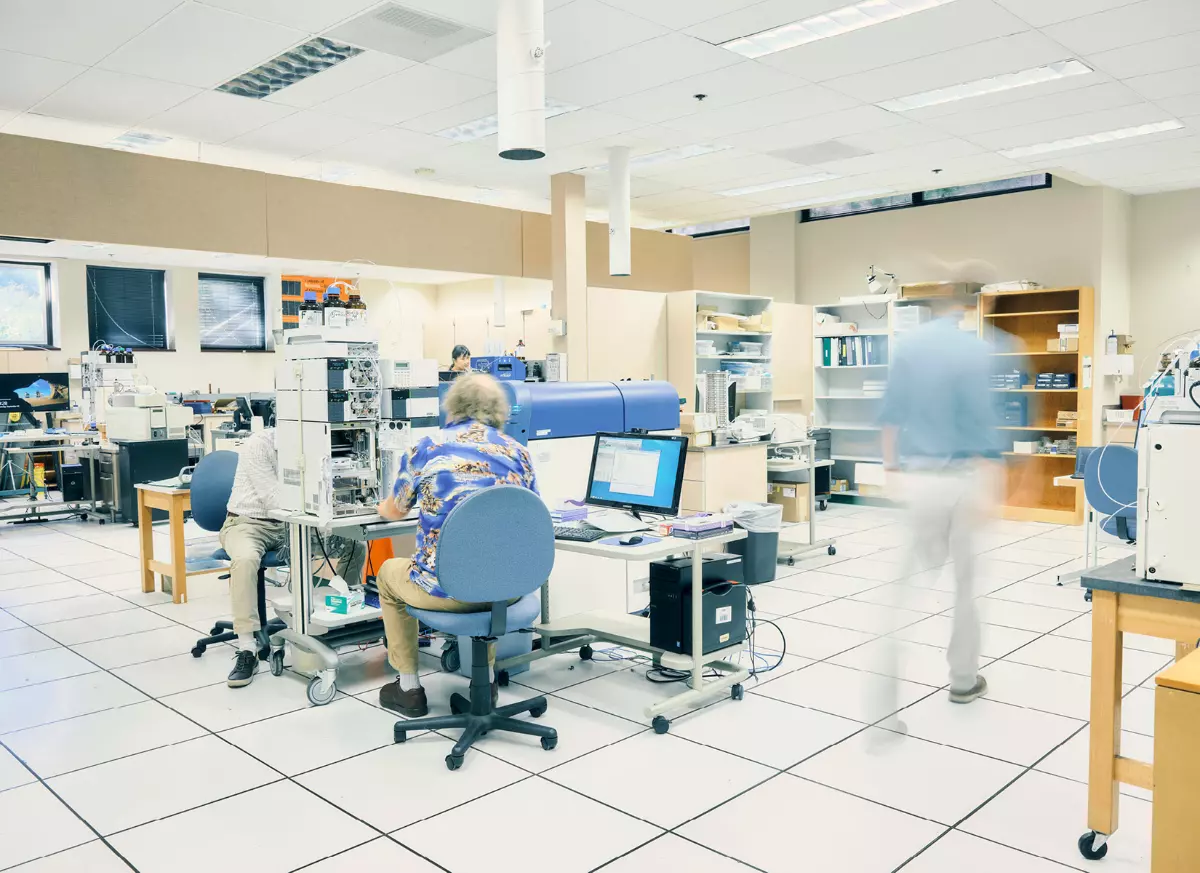In a basement lab on the leafy Oregon State University (OSU) campus in Corvallis, scientists in white coats hunch over equipment that appears to the uninitiated like large microwaves. It may not look like much, but a quiet revolution is underway here in Dr. Claudia Maier’s biomolecular Mass Spectrometry Center. Scientists here are working with the analytical chemistry professor on a brand-new piece of HP technology to demonstrate how it can isolate living cells from specimens so scientists can study which proteins are implicated in aging, dementia, and certain cancers.
Innovation
How HP is printing cells to help researchers learn more about age-related diseases
An HP device that dispenses single cells is empowering precision research at Oregon State University.
By Hannah Wallace — October 26, 2023

CAMERON MUNN
An early-morning view of the Agricultural Life Sciences building at OSU, which houses the Mass Spectrometry Center.
The HP D100 Single Cell Dispenser, which launched in early 2023, uses inkjet printer technology to dispense liquid samples containing cells in the 10- to 25-micron range — less than half the width of a human hair. This instrument uses advanced microfluidics devices — systems that can process tiny amounts of fluids — for cutting-edge research. In fact, it can isolate and dispense one cell at a time, enabling chemical analysis at a level of precision not seen before, for less cost, and with better outcomes.
“Until the D100, there were no reasonably cheap, robust devices that could do single-cell dispensing,” explains Stanislau Stanisheuski, one of Dr. Maier’s grad students. “Cheap and fast — those are two very important qualities.” Fast is important in this work because the longer the cells stay in suspension (in a saline solution), the more they degrade. Being competitive price-wise is also valuable because it means more scientists around the world will be able to use these instruments for revolutionary research and development.
The D100 was developed by the Life Science Solutions Business at HP over a period of three-and-a-half years by a small team of engineers and scientists. It both lowers the cost and increases the accuracy of Single-Cell Proteomics, an emerging field. The dispenser, which resembles a small printer, sells for an order of magnitude less than other competing technologies via HP’s commercial channel partner, Tecan. (Tecan has given the device a snappier name: Uno.) This is a major innovation because it will place this technology into the hands of non-specialist laboratories. While there are other cell isolation technologies, they have trade-offs: Some are generally very expensive (in the hundreds of thousands of dollars), can be stressful on cells, or are very slow. Most cannot dispense both cells and other chemicals.
The Single Cell Dispenser actually does what its name implies: it delivers individual, viable cells for testing. And it does it quickly and gently: In less than five minutes, the instrument dispenses 384 cells and the chemicals needed to help identify their components into a well plate, with very good cell viability. When that plate is later analyzed through mass spectrometry, the individual cells’ proteins can be identified and quantified.

Cameron Munn
Dr. Claudia Maier, analytical chemistry professor and Director of the Mass Spectrometry Center at Oregon State University.
Mass spectrometry in focus
In order to understand how revolutionary the D100 is, you have to know a little about incredibly sophisticated and expensive instruments called mass spectrometers. One in OSU’s Mass Spectrometry Center (which cost $1.5 million) uses electrospray ionization, a technique that applies high voltage to a tiny needle to transform biological samples into aerosols. These tiny droplets can be manipulated to eventually identify and quantify the proteins in the sample.
The only hitch is that samples usually have thousands, or even millions, of cells; and the mass spectrometer spits out the average of the proteins in all those cells. Because a sample may have many cell types, until recently researchers couldn’t study the proteins of individual cells. The HP D100 can reliably separate a sample of cells in solution and quickly isolate individual ones for mass spectrometry analysis. A new understanding of the diversity of individual cells’ proteins provides scientists with novel pathways to research more deeply the inner workings of biology.
As Jeff Nielsen, principal engineer and technology strategist at HP says, “They’d be able to get some information about cell samples and make decisions or conclusions, but it’s sort of like trying to understand what your lesson plan should be for an individual student in a classroom versus looking at the averages of the test scores of the entire classroom.”

Cameron Munn
Left: Graduate student Arpa Ebrahimi at the cell culture station. Right: Collecting live cells.

Cameron Munn
Graduate student Stanislau Stanisheuski uses a pipette to put a sample into the HP D100 Single Cell Dispenser.

Cameron Munn
Left: Jeff Nielsen, principal engineer and technology strategist at HP. Right: Micro-pipetting sample fluid into a cassette in the HP D100 Single Cell Dispenser, which will isolate and "print" individual cells into the well plate.
Just the right size
Back in the lab, the HP D100 hums along as each cell is dispensed into a single well. The D100 can also dispense reagents — substances (such as a chemical or drug) that can facilitate a reaction — in amounts of ten to 40 picoliters at a time. (A picoliter is one-trillionth of a liter.)
The precision enabled by the HP D100 elevated Dr. Maier’s work into an emerging research area called Single-Cell Proteomics (SCP), a field of study that aims to understand the diversity of protein expression within individual cells. SCP promises to advance biomedical research, from fundamental biological research to biomedical engineering and clinical applications.
“Single-Cell Proteomics is super new and it is absolutely not established,” Dr. Maier says. “Most groups that do Single-Cell Proteomics — and there are not so many yet — do technology development.” What she means is that before you can get to the impactful stuff — isolating single cells from the hippocampus, for example, and figuring out which individual cells are implicated in dementia — you have to prove to the scientific community that this new-fangled technology actually works.
And the D100 works. Hyo Sang Jang, Ph.D, a biologist and one of the HP application scientists who developed the D100, says the idea was to develop a nozzle that was “just the right size” to dispense one cell. “If it’s too small, the cell will get stuck. If it’s too large, it’s hard to control the size or the volume of the dispensing.” The other advancement of the technology was to keep the cell intact until scientists are ready to “lyse” it — disrupt the outer membrane of the cell to release intra-cellular materials such as proteins.

CAMERON MUNN
Dr. Claudia Maier’s analytical chemistry group at Oregon State University, including HP's Jeff Nielsen and Hyo Sang Jang.
Close collaboration
Two years ago, Ph.D graduate student Stanisheuski saw the device in a virtual workshop run by HP and was stunned.
“I thought, ‘Wait a second. This is exactly what I need for the project I wanted to do for so many years,’” recalls the scientist, who is from Belarus. “There were a couple of other groups that used a very expensive handmade robotic fluid-handling device. They actually got to the single-cell level, but it wasn’t reproducible in any other lab.”
Stanisheuski says it took him and Dr. Maier about a month to conduct a study to prove that their existing lab instruments could be used in Single-Cell Proteomics, and another few months for HP to select the lab to try using the D100 prototype. Both teams recognized that it was a risky project, but the possibility that the university could make an impact in this exciting new field and also show that HP’s instrument was useful in the process was too exciting to pass up.
HP engineers started training Dr. Maier’s students, including Stanisheuski, Arpa Ebrahimi, and Kavi Vaidya, on the prototype of the D100 in December of 2021. In January of 2022, hers was among the first labs to get the device. A close collaboration followed, with the OSU scientists giving regular feedback to help perfect the technology.
“They were able to address almost every single issue that I brought to them,” says Stanisheuski. “The result of this process is the device that we have right now,” he says.

Cameron Munn
Left: After the cells are dispensed, an image of each well is created to demonstrate that the dispensed cells are intact and viable. Right: Dr. Claudia Maier and graduate student Stanislau Stanisheuski reviewing proteomics data.

Cameron Munn
Left: Graduate student Arpa Ebrahimi using the mass spectrometer. Right: Replacing the needle seat to prepare for nano-liquid chromatography, one of the many steps in the lab workflow.
Revolutionizing research
As part of the multi-step workflow that Dr. Maier’s students follow to validate the accuracy of the D100, they first have to image the dispensed cells in a well plate. “That imaging part is very important because it shows that the dispenser from HP was able to dispense intact, viable cells,” Maier says. After imaging, the sample is lysed with either a freeze/thaw cycle or with heat and processed for analysis before the mass spectrometer can do its job.
The HP software would originally put an “X” on the screen in the wells that did not have an intact cell in it, but now there’s a function called the “junk well,” where all the non-intact cells go to die. Of the 384 wells in the plate, about 90% emerge with an intact, viable cell, HP’s Nielsen says. “The junk well was an improvement to our performance that we made partially based on feedback from users like [at] OSU,” he says.
Both Stanisheuski and Ebrahimi say that having access to the HP D100 has re-energized their work. “It’s completely changed my whole perspective about my research,” Ebrahimi says. “There’s a lot of nuance there that needs to be discovered.”
Ebrahimi is working with PC12, neuron-like cells, to see how they “differentiate” after adding nerve growth factor (NGF). Over the course of six days, she tracks protein signatures as the cells change size, shape, and functions in response to the NGF. “You want to see the progression of cells. What actually changes during that process? What proteins are being expressed more or what proteins are being expressed less?”
Answering these questions now will open the door to Ebrahimi and other scientists, in the future, using the HP D100 to study neurodegenerative diseases like Alzheimer’s or Parkinson’s. Ebrahimi is also using the D100 to isolate cells to determine their lipid composition, which are important in a lot of biological pathways. (Technically this is not proteomics, but still interesting for future research in how individual cell metabolism affects the body.) Stanisheuski, and a team of co-authors — including Ebrahimi and HP’s Jang — will soon be submitting a paper on their work with the HP D100 to Frontiers in Chemistry.
In the near future, Dr. Maier hopes she and her team will be able to use the D100 to study the different cell types that make up a tissue, such as in a tumor. “We don’t really know much about how the different tumor cell populations biologically differ and become aggressive cell types,” she says. “A deeper understanding of the biology of these different cell types has the potential to inform treatment strategies for patients with cancers.”
Stanisheuski, for one, can’t wait to begin: “We’re excited about it because the technology actually works.”







